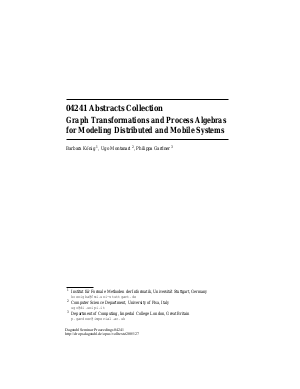04241 Abstracts Collection – Graph Transformations and Process Algebras for Modeling Distributed and Mobile Systems
Authors Barbara König, Ugo Montanari, Philippa Gardner
-
Part of:
Volume:
Dagstuhl Seminar Proceedings, Volume 4241
Part of: Series: Dagstuhl Seminar Proceedings (DagSemProc) - License:
 Creative Commons Attribution 4.0 International license
Creative Commons Attribution 4.0 International license
- Publication Date: 2005-02-18
File

PDF
DagSemProc.04241.1.pdf
- Filesize: 351 kB
- 41 pages
Document Identifiers
Subject Classification
Keywords
- graph transformation
- process calculi
Metrics
- Access Statistics
-
Total Accesses (updated on a weekly basis)
0Document
0Metadata
Abstract
Recently there has been a lot of research, combining concepts of process algebra with those of the theory of graph grammars and graph transformation systems. Both can be viewed as general frameworks in which one can specify and reason about concurrent and distributed systems. There are many areas where both theories overlap and this reaches much further than just using graphs to give a graphic representation to processes. Processes in a communication network can be seen in two different ways: as terms in an algebraic theory, emphasizing their behaviour and their interaction with the environment, and as nodes (or edges) in a graph, emphasizing their topology and their connectedness. Especially topology, mobility and dynamic reconfigurations at runtime can be modelled in a very intuitive way using graph transformation. On the other hand the definition and proof of behavioural equivalences is often easier in the process algebra setting. Also standard techniques of algebraic semantics for universal constructions, refinement and compositionality can take better advantage of the process algebra representation. An important example where the combined theory is more convenient than both alternatives is for defining the concurrent (noninterleaving), abstract semantics of distributed systems. Here graph transformations lack abstraction and process algebras lack expressiveness. Another important example is the work on bigraphical reactive systems with the aim of deriving a labelled transitions system from an unlabelled reactive system such that the resulting bisimilarity is a congruence. Here, graphs seem to be a convenient framework, in which this theory can be stated and developed. So, although it is the central aim of both frameworks to model and reason about concurrent systems, the semantics of processes can have a very different flavour in these theories. Research in this area aims at combining the advantages of both frameworks and translating concepts of one theory into the other. The Dagsuthl Seminar, which took place from 06.06. to 11.06.2004, was aimed at bringing together researchers of the two communities in order to share their ideas and develop new concepts. These proceedings4 of the do not only contain abstracts of the talks given at the seminar, but also summaries of topics of central interest. We would like to thank all participants of the seminar for coming and sharing their ideas and everybody who has contributed to the proceedings.
Cite As Get BibTex
Barbara König, Ugo Montanari, and Philippa Gardner. 04241 Abstracts Collection – Graph Transformations and Process Algebras for Modeling Distributed and Mobile Systems. In Graph Transformations and Process Algebras for Modeling Distributed and Mobile Systems. Dagstuhl Seminar Proceedings, Volume 4241, Schloss Dagstuhl – Leibniz-Zentrum für Informatik (2005)
https://doi.org/10.4230/DagSemProc.04241.1
BibTex
@InProceedings{konig_et_al:DagSemProc.04241.1,
author = {K\"{o}nig, Barbara and Montanari, Ugo and Gardner, Philippa},
title = {{04241 Abstracts Collection – Graph Transformations and Process Algebras for Modeling Distributed and Mobile Systems}},
booktitle = {Graph Transformations and Process Algebras for Modeling Distributed and Mobile Systems},
series = {Dagstuhl Seminar Proceedings (DagSemProc)},
ISSN = {1862-4405},
year = {2005},
volume = {4241},
editor = {Barbara K\"{o}nig and Ugo Montanari and Philippa Gardner},
publisher = {Schloss Dagstuhl -- Leibniz-Zentrum f{\"u}r Informatik},
address = {Dagstuhl, Germany},
URL = {https://drops.dagstuhl.de/entities/document/10.4230/DagSemProc.04241.1},
URN = {urn:nbn:de:0030-drops-279},
doi = {10.4230/DagSemProc.04241.1},
annote = {Keywords: graph transformation , process calculi}
}
